You know when I mentioned earlier that not a lot of things were going right? Yeah, still at it.
We’ll start with a photo outing with Mr Bugg, intended to chase birds and the sunset, though I already suspected the sunset wouldn’t be too fascinating, since the sky was completely free of clouds. We had several good passes from vultures and osprey, but for reasons unknown, the autofocus on my Tamron 150-600 lens wasn’t locking on very well, something that I discovered only upon returning and examining the photos in detail. This is curious, because the conditions were a lot less demanding than the airshow where it had gotten its shakedown cruise, as it were, and where it performed admirably. So far, I have found no reason for it to have been different in this case, but the end result is, a hell of a lot less useful images than intended, and a very poor keeper rate.
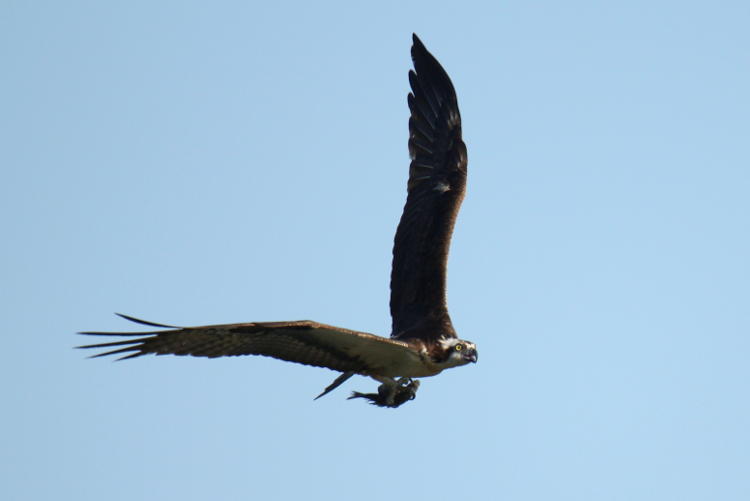
I heard the chirp of this osprey (Pandion haliaetus) before it even cleared the trees and so was watching out for it, but it dropped into the lake after a fish before I could get the focus locked on, spoiling my chance for a sequence of the capture. After it rose up with its meal, I got several images, all of which aren’t really bang on sharp. Yes, I’m concerned about this.
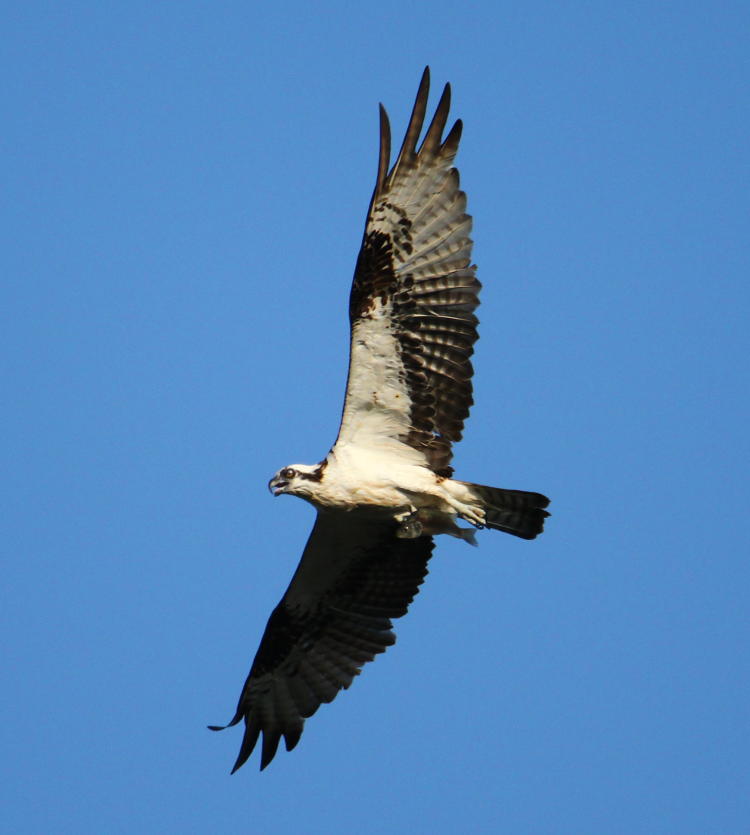
This is another one, carrying a fish that we never saw it capture, and seriously, you can’t ask for better autofocus conditions than this (these are tighter crops than the originals, by the way, which exacerbates the poor focus.)

Above is one of the few truly sharp images, so of course it’s of a pose that isn’t terribly photogenic. I would definitely have preferred to have the one below to be sharp, if the AF was going to be so selective, since the bird was looking right at us as it passed, but noooo, why would something go smoothly for Al this past month?
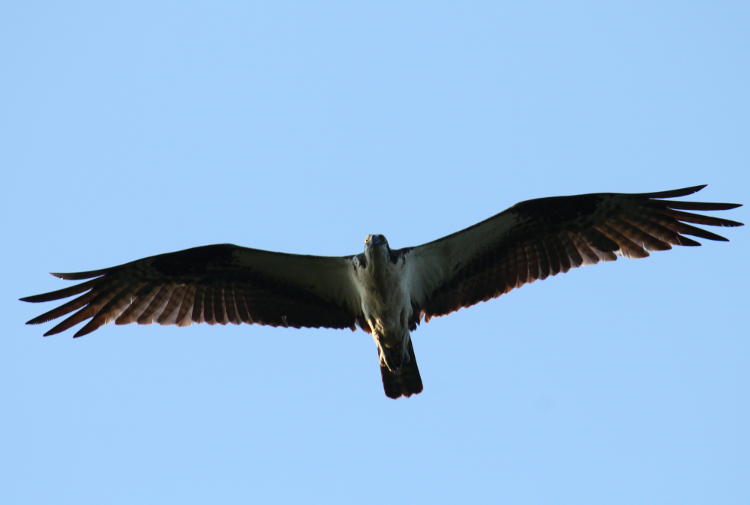
And then there was the sunset, where the only thing of interest that we pulled from it were some faint crepuscular rays, or crepuscular shadows perhaps, that if you looked closely, stretched across the entire sky. Bear in mind, this image is with increased saturation and contrast.
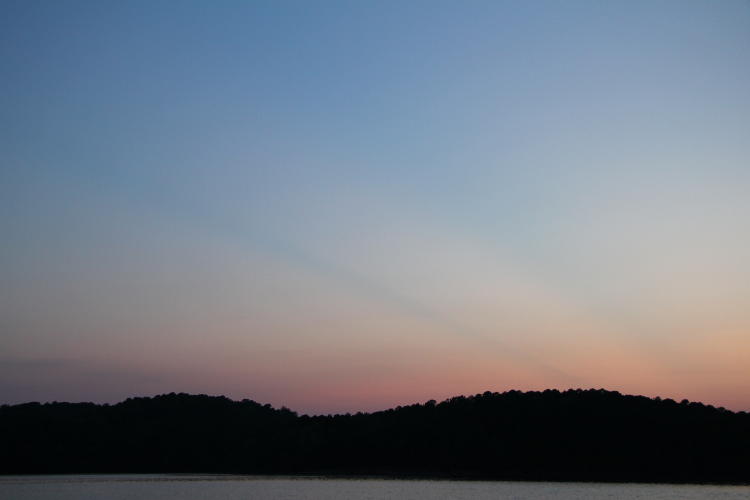
A day or so later, I was about to do some work on the exterior of the car, and a pesky red wasp with black wings was weaving around my legs rather insistently. I managed to chase it off, but only for a meter, where it paused on one of the potted plants. I was beginning to think that it had started a nest on the car or something, since it was behaving as if there was something important about the area, as I sat down on the driveway – then I saw the spider right next to me. It was a large wolf spider, sitting with its legs all drawn together, kinda bunched up, which is far from typical. I blew on it, and it didn’t even twitch, which is when I made the connection. Several different species of wasp paralyze spiders and take them back to a burrow or nest, where the wasp lays eggs in the spider’s body. The young hatch out and consume the still-living (for a bit, anyway) spider before they emerge from the nest. I had interrupted the process between the paralyzing sting and the subsequent transport back to the baby’s bedroom. Since I have never captured any part of this behavior, I quickly ran inside and gathered the camera and macro flash, which took from 45 to 60 seconds, but by the time I returned both spider and wasp were gone. Well, shit.
Later on that evening, the sky, the real-time lightning map, and the weather report all indicated that electrical storms were brewing immediately south, and I threw my camera and tripod in the car and headed back down to Jordan Lake, the same one with the osprey and ho-hum sunset, since it has the best wide views in a tri-county region. Central North Carolina is not friendly to storm chasers, because of the numerous trees and gentle hills which serve to hide approaching storms – you really want flat, open areas. The lake is only about 20 km away, maybe a 15-minute drive, so I figured I had a chance. One the way, I could see some lovely ground strikes, a lot closer than any of my sources had indicated, and towards the end of the journey it almost seemed like I was passing them, but I’d still have a good view for 180° or so around me, so I wasn’t too worried. Except that, literally 30 seconds before I was to pull in the access drive to the boat ramps, the raging downpour began. Naturally enough, this isn’t very conducive to being out with a camera, but even worse, such conditions mean a low cloud cover and obscuring rain, so lightning usually stops being visible unless it’s right on top of you. I sat in the car for a few minutes to see if it would pass quickly, then simply gave up and drove back home.
I soon drove out of the rain, then through a couple of wet spots where it had passed in the brief period between my outward and homeward legs, all the while noticing that the lightning was now north. There was still some flashing going on as I got back, so I trotted down to the nearby pond to see if I could capture anything there. It was pretty clear that there were two main cells, and that they were a little too distant to provide much of a view.

This is mostly what I saw, even after I switched position to take advantage of where the cells seem to be concentrated.
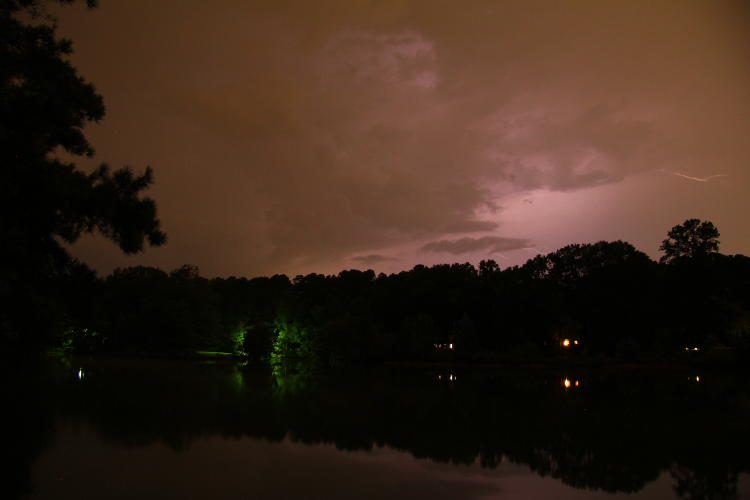
Well, it’s proof that there was indeed lightning, but not much more than that.
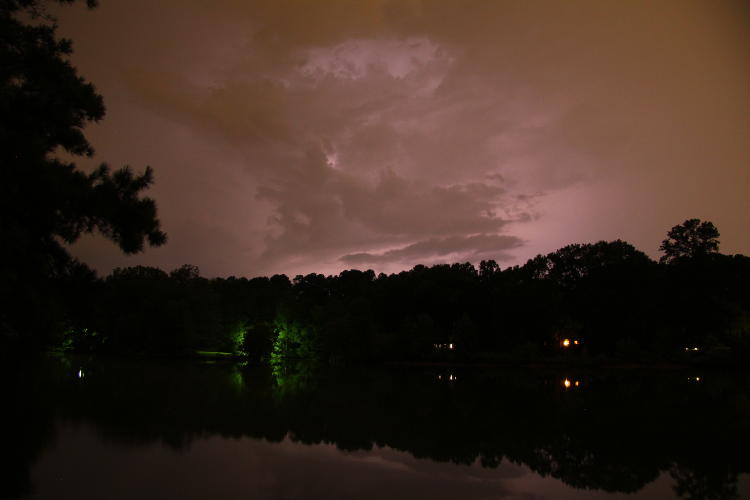
Views like this aren’t really visible when you’re watching them – or to be honest, they’re visible almost exactly like this, but for a tiny fraction of a second while your eyes are adapted to the darkness, so you never see this kind of detail. But still not what I was after.
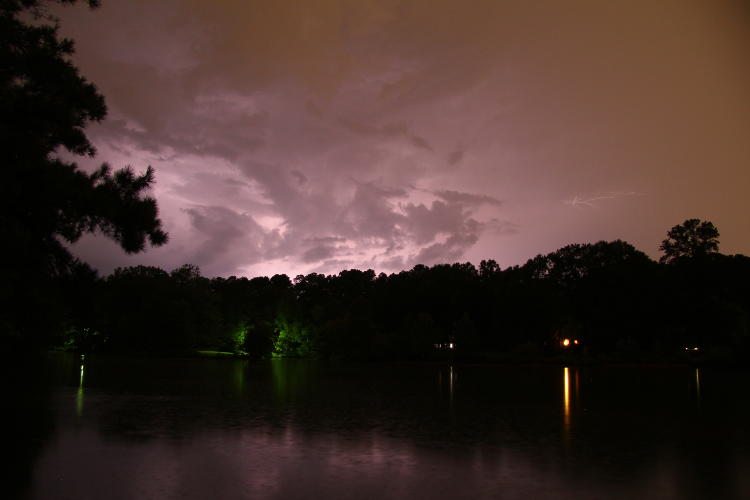
This one actually shows activity from both cells – the second one is just out of view behind the tree to the left, but provided a bright enough flash to help delineate the clouds surrounding the cell in the center of the image. Also note the difference in the water reflections between this frame and those further above it; the rain was starting again in earnest, rippling the water of the pond. I was about to head in at this point.
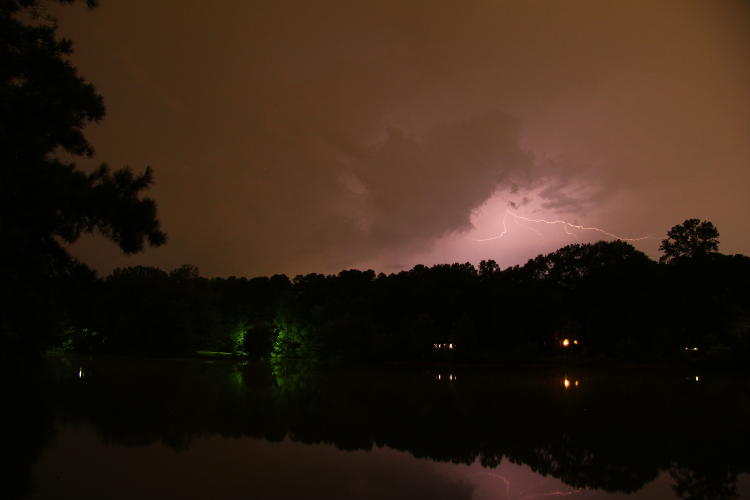
Annndddd this was the best I got, a little earlier in the storm before the rain started getting noticeable. It was obvious that I was a few kilometers too far south to see real activity, but also possible that being closer wouldn’t have netted anything because I’d be in the rain. Either way, I could think of no good viewing locales in that direction, plus the idea that, by the time I traveled up there, the activity would likely have ceased, because that’s the way it’s been going.
I will close with one shot from after that sunset shoot, as the sky darkened down and the first stars became visible. Actually, the first thing to become visible was a planet, not a star, which is typical; we were guided to look in its direction by my Heavens Above app, since I knew Jupiter would likely be brighter than anything else that evening. Manually focusing with the 150-600 and doing a lot of playing around with mirror lockup for stability, I got a few decently clear shots of Jupiter and the four Galilean moons: Callisto, Europa, Ganymede and Io, just, not necessarily in that order. This, by the way, is full resolution, and the best I was going to get without a telescope. Maybe some day I’ll approach this in earnest.

A couple of quick notes. First, Jupiter’s stripes could be made out at this resolution, but not at this exposure; if the exposure was reduced enough to make them out, the moons virtually disappeared. I did do a few exposures like this, but the focus left a lot to be desired (strictly manual – Jupiter was little more than a speck in the viewfinder.) Second, this is the first time in my experience (over years) where the moons were not in a perfect line, and I suspect we’ve reached a point where we’re no longer lined up with Jupiter’s ecliptic plane, as we might have been every time I’ve done this before. I’ll have to look into it…




















































